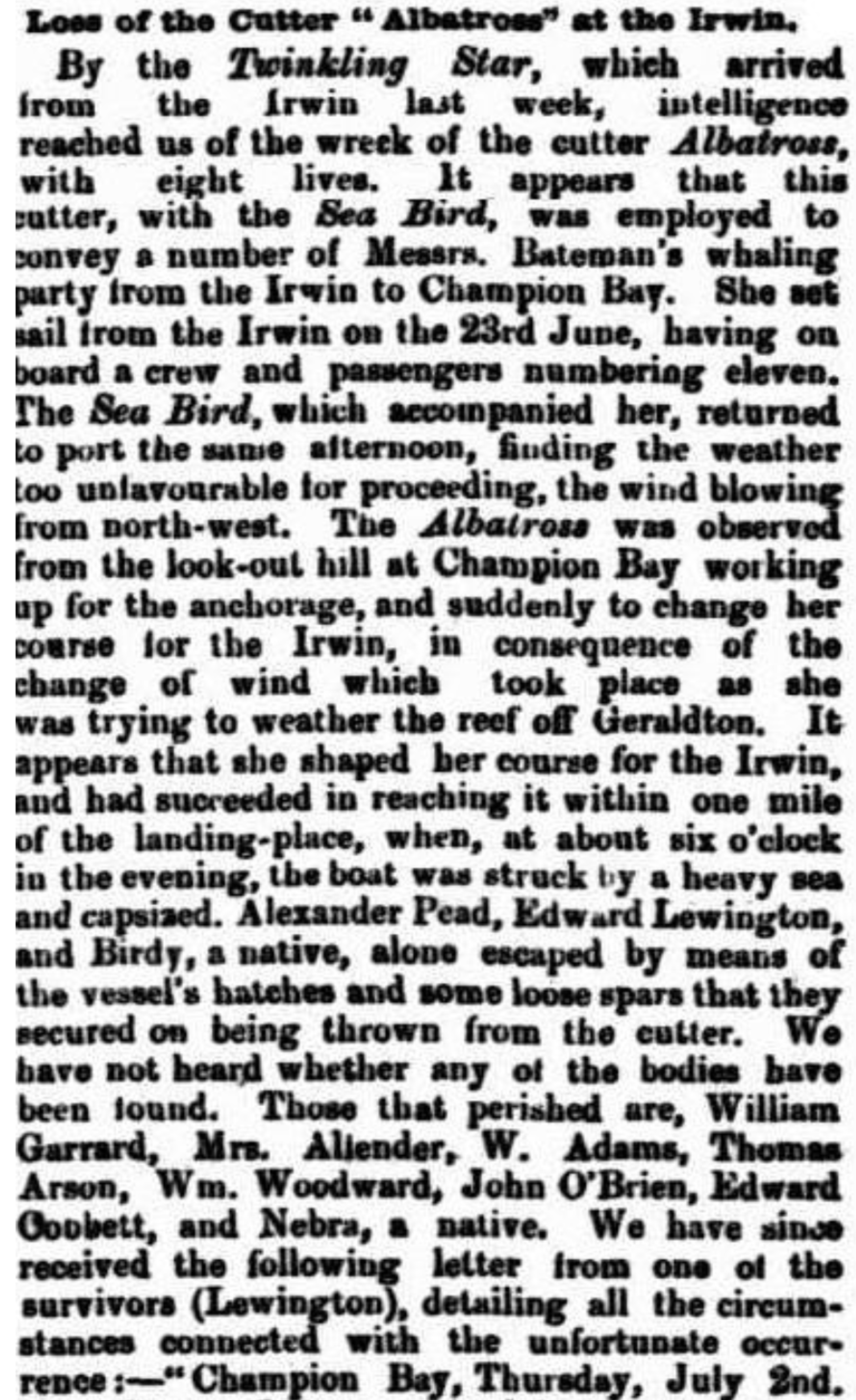Albatross
Vessel Name: Albatross
William Garrard
John Bryan
William Adams
William Woodman
Thomas Aaron (ticket-of-leave convict)
Moke and Nabra (two Aboriginal whaling crew members)
Margaret Allender
Boat built from the wreck of Africa; All wrecked; All Persons Lost at Sea
25 June 1868
** Please Also Refer to the Lass of Geraldton Story **

The Inquirer and Commercial News, Wednesday 15 July 1868
The Albatross was an 18-ton cutter built by shipwright William Garrard of Geraldton, who had emigrated from the Channel Islands to seek his fortunes in Western Australia. Along with the Lass of Geraldton and the Mary Ann, Albatross was built from the timbers salvaged from the hull of the African, a 780-ton cargo ship which foundered on the reef outside Champion Bay on 1 January 1863. William bought the timber to build his three boats and set about their construction in Geraldton.
From new, the Albatross was licensed for harbour work in the busy Champion Bay. With the number of fishing boats increasing and the coming and going of cargo and passenger ships, Albatross was kept busy servicing the needs of those in the harbour area and transporting fish to Fremantle.
In June 1868 there were strong storms along the Midwest coast. On 15 June the coastal traders Sea Bird and Twinkling Star were dragged ashore at the Irwin River, south of Champion Bay. They were transporting members of a whaling crew to the whaling base at Port Gregory. On 20 June, Albatross was sent with carpenters and equipment to re-float the stranded vessels. The venture was successful, and Albatross and Sea Bird set off for the return steam to Champion Bay on 24 June. Albatross boarded members of a whaling party employed by affluent merchant Mr John Bates of Fremantle. William Garrard, her builder and owner, was also aboard as Master. Reportedly he often sailed Albatross himself.
By afternoon of 25 June, the Sea Bird returned to Irwin, when the winds shifted to the north westerly squalls, and proved too harsh for her to battle. She made the return although was pushed ashore again. She lost her false keel, split her stern post and lost her rudder irons but managed to ride out the storm riding to three anchors.
Albatross continued on to Point Moore but was seen to change course and turn back when she was unable to weather the reef near Point Moore. It is unclear why she decided to return to Irwin Point, rather than seek safe harbour at Port Gray. She made the inside of the outer reef and was making for the Port Anchorage when a dumb breaker rolled over her, filled the mainsail, shifted the cargo and rolled the boat.
At 6pm Albatross was approximately 1.5 kilometres from shore, at the mouth of the Irwin River when she was swamped by heavy sea. She was de-masted; the deck cargo was carried away and her passengers were thrown into the sea. She rolled over and over in the trough at the river mouth, turned by the heavy seas.
Of the eleven people on board the Albatross, only three were able to swim to shore. They were Alexander Pead, Edward Lewington and Birdy (an Aboriginal whaling crew member). These three escaped and managed to stay afloat by using the Albatross’ hatches, and Birdy got onto a bag of bran from the boat’s cargo. Lewington recounted his ordeal in a letter to his sister, which was later published in a local newspaper. He wrote that he had been aboard Twinkling Star from Fremantle to Irwin and was transferred with others of the whaling crew to the Albatross.
The remaining eight people were drowned. They were William Garrard, John Bryan, William Adams, William Woodman, Thomas Aaron, Moke and Nabra (two Aboriginal whaling crew members) and the only female on board, Margaret Allender. Thomas was a convict (No. 255). It was common to hire ticket-of-leave holders for mining, farm and fishing work, and the Midwest region had Hiring Stations, such as the one that is preserved at Lynten Station (1853 – 1856) near Port Gregory (where the Pakington Whaling Station (1854 – 1875) was located).
The other boats built from the Africa also met with tragic ends.
The Lass of Geraldton capsized in a squall off Mandurah, steaming from Fremantle to Bunbury in ballast on 23 February 1867. Two crew members and two passengers were drowned.
The Mary Ann was leaking, and driven ashore in May 1865, while steaming to Champion Bay.
Sadly, William Garrard’s son, William Jr, was lost when the Gem foundered off the Fremantle coast when steaming from Irwin in May 1878. William was the mate on the Gem, awaiting his 21st birthday so that he could sit for his master’s ticket. All the crew were drowned, and this fuelled the superstition that William Garrard had bought bad luck when he purchased the timber from the Africa.
Those who were superstitious about using salvage from wrecks merely commented that it was no surprise the cutters met with untimely and tragic ends. The loss of the cutters also fed into the growing public fear of the Midwest coast, with the waters around Geraldton being labelled the ”most sinister of the death-dealing coast” by the West Australian Newspaper in 1936. The Advertiser newspaper of Fremantle quoted a poet who wrote
Were I to curse the man I hate from youth till I grow grey,
Oh, might he be condemned by Fate to live in Champion Bay.
